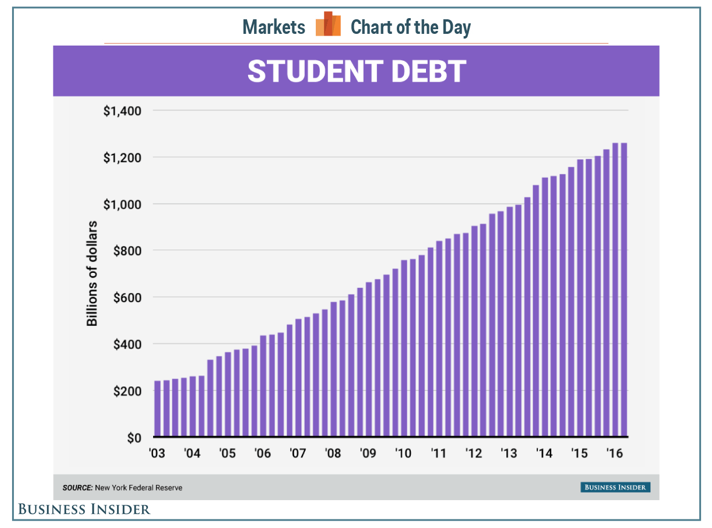Take a look at this chart:
 Basically, what this chart is showing you is that America has a massive student loan debt problem. Want to know what the next ‘housing crisis’ will be? It’s right here in this chart!
Basically, what this chart is showing you is that America has a massive student loan debt problem. Want to know what the next ‘housing crisis’ will be? It’s right here in this chart!
The average student is now leaving college with over $35,000 in debt. This has a trickle down effect that college and universities could care less about, the government could care less about, and every Presidential candidate could truly care less about.
I have friends in High Education who will be pissed I say that colleges don’t care about this problem, but they don’t. They’re in the business of empire building. Listen to Malcolm Gladwell’s podcast “Revisionist History“. He does a three-part series on how broken higher education is, and there is no easy way out!
Don’t kid yourself, Hill or Trump, isn’t going to help those in debt. They might try to solve this issue for future students, but those poor saps who already signed loan agreements will be on their own! You can take that to the bank.
So, this becomes your problem, the organizations, and companies that hire all these graduates with all this debt.
How is it your problem?
1. Debt causes stress.
2. Stress causes problems – lack of productivity is just one that will directly impact all organizations.
3. You have to solve the biggest problems in your organization.
4. This will soon become your biggest issue.
5. Financial wellness programs aren’t equipped to handle a problem of this magnitude!
What should you do?
Do you really want to know? This might not be very popular!
– Stop requiring a college degree for employment in your organization. Companies and organizations have actually contributed to this problem. It’s the college or prison mentality we’ve forced upon kids. “You must go to college or you’ll have no options!” Well, except for almost any position we hire for, but we’re lazy and like to use an arbitrary piece of paper as a screening tool.
– Develop ‘Apprentice’ programs for a modern age. Why don’t we have Sales Apprentice Programs? Bright-eyed-bushy-tailed kids right out of high school who still believe they can be anybody. Why aren’t we teaching them ourselves? No, let’s send them to college to learn how to drink beer first, then we’ll teach them on our own. You could do the same thing for almost any role you have – many engineering/technical roles included!
– Develop programs that assist your employees in paying down this debt faster and with less interest than they currently have. Yes, there is a retention aspect to this. Yes, this will require some service as a payback. Yes, this will help your employees be less stressed!
All of these cost money to organizations and companies, but you need to make a choice. Do you want to control that cost yourself, or do you want to deal with in the future for everyone you hire? It used to be that companies invested into their workforce. Then we got lazy and tried to throw this onto high ed. Turns out that doesn’t work too well.
Get ready kids! Employees with big giant monthly debt payments are coming your way and they won’t be very happy when the reality of what they did comes crashing down upon them. Have fun with that!

